The Canary Islands are a lonely beach paradise off the coast of northwest Africa. Here's how to have them in your life.
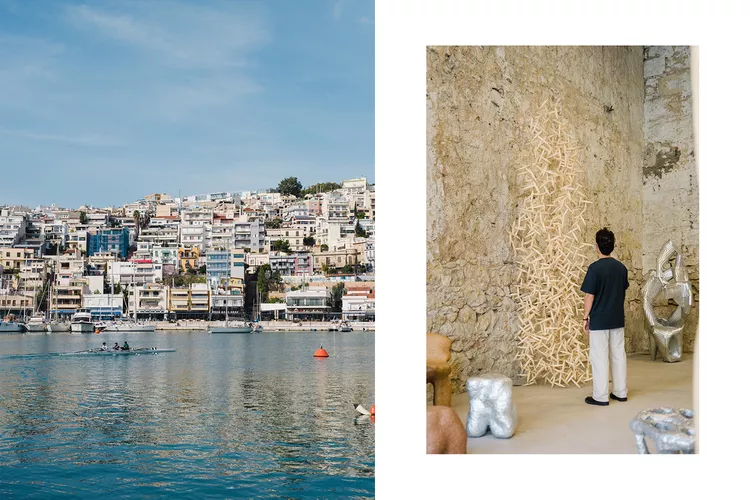
I relocated to the Greek island of Tonos a few years ago after leaving my home in Athens. Even though I had never lived on an island before or spent a significant period of time anywhere without an airport, I quickly got used to it. Islands are remote in every sense of the word; time passes more slowly, and people tend to be more self-reliant. I fell in love with the peaceful way islanders lived and became fascinated by how nature and the elements govern daily life because I was surrounded by horizon and could only leave by boat.
After that, I began studying the Canary Islands.
Off the northwest coast of Africa, the Canaries, a Spanish archipelago of seven major islands and a number of smaller islets, express the geological and biological diversity of the world with its wet laurisilvas (laurel forests), rocky deserts, unpredictable volcanoes, and tropical beaches. Each island has its own unique energy and, in certain circumstances, its own distinct microclimate.
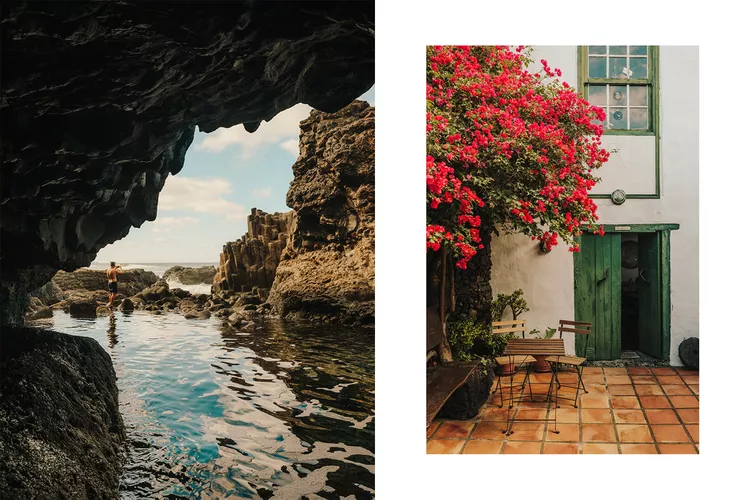
But when you think of the Canaries, you might not immediately picture rocky, natural scenery. The two main islands—Gran Canaria and Tenerife—became well-liked vacation destinations for sun-starved northern Europeans starting in the 1960s, and mass tourism as we know it today was established. These were places to go for a mai tai by the pool and a Club Med-like feel, but not much else.
Stereotypes intrigue me, or rather, their dismantling. I took a flight to Tenerife, the most populated of the Canaries, near the end of June of last year. I picked up a rental car at the airport and left my things at the expansive Ritz-Carlton, Abama, which is located on the western coast's sandy beaches. With wood-trimmed balconies and exteriors painted the same shade of red as the area surrounding Pico de Teide, the island's dormant volcano, its style is an homage to North African architecture. The Ritz-Carlton is one of the numerous magnificent hotels on Tenerife that are popular with families and couples. It also makes a great home base for exploring.
I came across a hand-painted sign reading Fukuoka Farm as I traveled north across verdant rolling hills. I made a screeching, exceedingly illegal U-turn on the steep road. For certain types of agriculture-obsessed persons, the name of Masanobu Fukuoka, the Japanese farmer and philosopher who developed "do-nothing" farming, is a bat signal. Being one of them, I drove my car down an unpaved dirt road to investigate. When I got to the finish, I was cordially welcomed into a family's home.
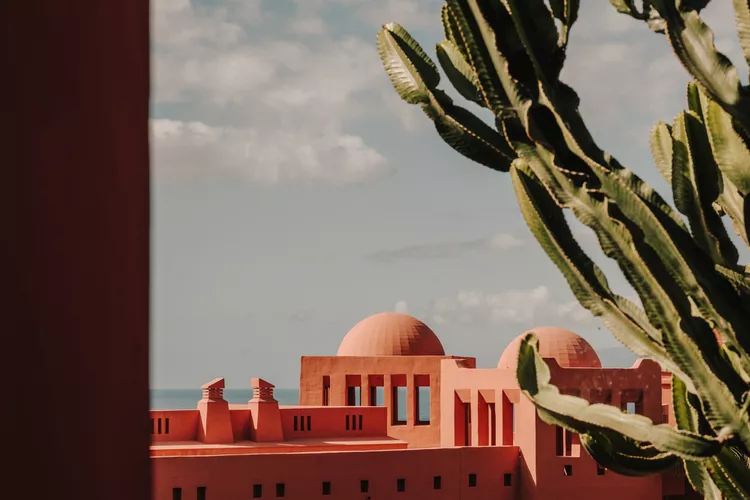
Federico Negrisolo and his spouse Romina relocated to Tenerife from their home in Italy over 10 years ago in search of a more conscious way of life, one that was free of urbanisation and intense commercialization and deeply rooted in nature and the rhythms of the seasons. Over tea in their living room, Negrisolo said that "living like this is a philosophy." They employ Fukuoka's methods to cultivate their own crops, like cabbage and lettuce, which they sell in local markets and give tours to tourists upon request. "We can't fix decades of bad agricultural treatment of the earth in one day, but we can contribute," they say.
The two demanded I stay for lunch, so as they made an omelette (with eggs from their chickens) and boiled potatoes, I entertained their toddler daughter and infant son. The potatoes tasted like they had been marinated for hours since Tenerife's soil is so rich in minerals, despite the fact that they were made without any seasonings. My first experience with gofio, a Canarian staple made from ground cereal (Romina makes hers from homegrown lentils), was when Federico placed a jar of powder in front of me. I took a teaspoon, tasted it, and immediately sprinkled it liberally across my plate.
The family gave me a tour of the garden and waved goodbye as I climbed back up into the mountain fog. Then, as it often does in Tenerife, which some claim has 28 separate microclimates, the weather shifted, and a hot wind pushed me back south toward the Ritz-Carlton pool.
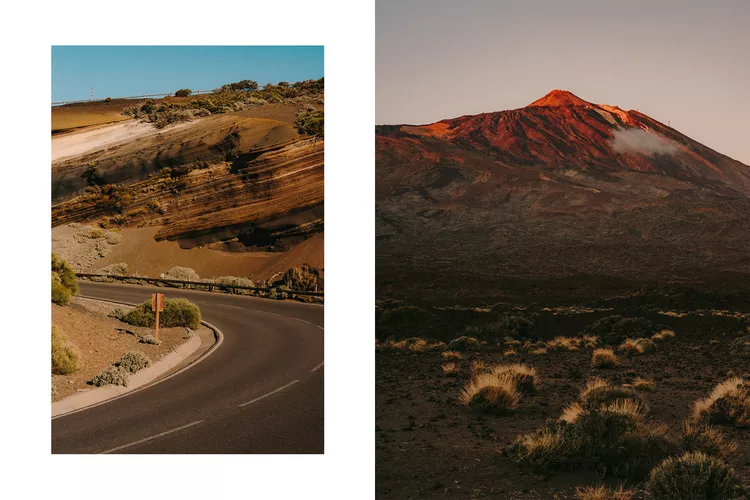
The indigenous Guanche inhabitants of the islands had the greatest explanation for the weather's constant changes. They thought Guayota, the demon, lived on Spain's tallest peak, Teide. The Supreme Being, Achamán, would soothe him down when he became enraged, causing the earth to tremor and the sun to become dark. The Guanche people used to climb the mountain every summer with their herds of goats before the arrival of the Spanish in the 15th century.
Teide rises like a lump of dough in the centre of the island. Although it was grounded on the day I arrived due to heavy winds, there is a cable car that transports tourists halfway to the peak nowadays. Whatever, there was plenty to see around the volcano, including enormous chunks of dried lava poking up from the ground and forming a strange, tactile landscape. I climbed rocks while the wind around me grew stronger. It seemed as though you were in a geologist's dream.
Only a witch could have conjured the laurisilva at Anaga, on the island's northeastern tip: this untamed region of ravines and mountains is covered in bright-green laurel trees, their branches bending toward one another in secret conversation. If a geologist imagined up Tenerife's center, then only a witch could have conjured up the island's center. I took deep breaths of fresh air as a moist mist drifted through the scene at Anaga Rural Park. I crouched down to examine a moss-covered limb when I saw some small, almost transparent mushrooms growing there. I never encountered another person. I assume that everyone else was at the beach.
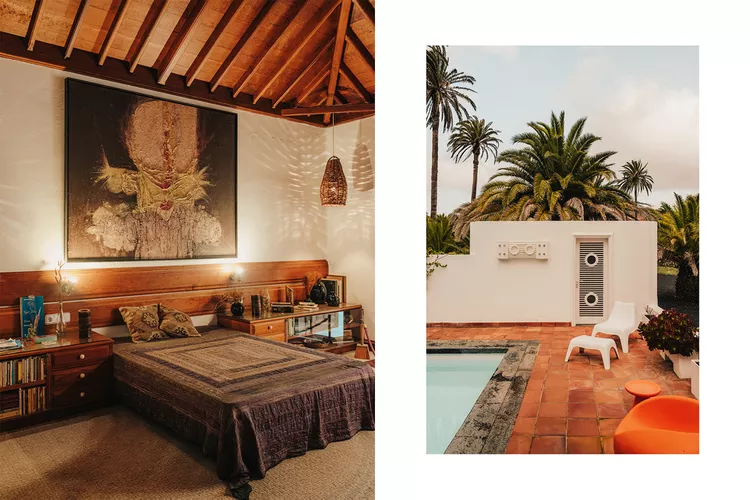
On El Hierro, the smallest of the main islands and a UNESCO Biosphere Reserve that relies almost exclusively on wind and hydroelectric power, I discovered even fewer people. A few people were waiting for their loved ones to arrive at Puerto de la Estaca, a small port close to the island's capital, Valverde, as I traveled there by ferry from Tenerife. The boat pitched and rolled in the frothy Atlantic waves, but after two and a half hours I arrived, stomach mostly intact.
With a population of only 11,500, El Hierro is the westernmost island in the archipelago. As I drove through tunnels and around some of the island's numerous volcanic cones, I immediately felt alone. My automobile was frequently the only moving object on the road, and the only radio station I could find played gloomy Catholic songs. The 104 square miles of El Hierro are home to tropical mountains, tide pools, arid plateaus, soggy woods, and deep valleys. The water around the southwest end is a marine reserve, making it as perfect a location for hikers as it is for divers.
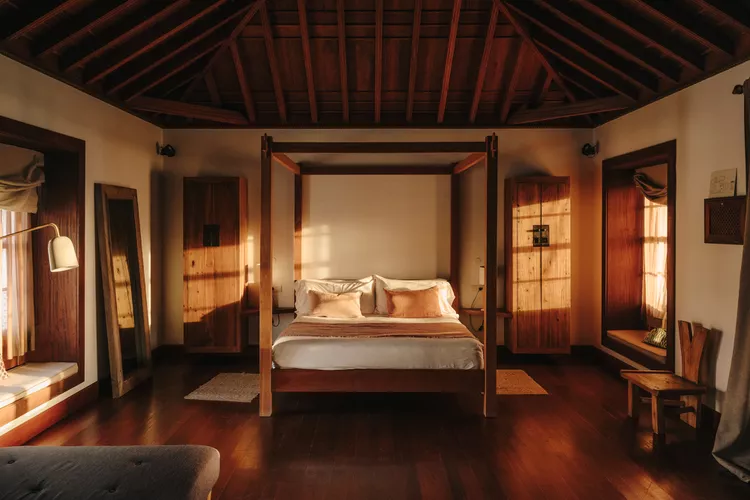
On the island, there isn't much development and certainly no resorts, but on a wave-battered outcrop of volcanic rock, I discovered Hotel Puntagrande, the most luxurious hotel on the island—or, to be more precise, hotelito, as it only has four rooms and one suite. Five years ago, its owners, Italian David Nahmias and his Spanish-Colombian wife Paula Pascual Luna, left their hectic lives on the continent of Europe in pursuit of a more peaceful, natural way of life. The 1830 stone fisherman's house has been stocked with so many maritime artifacts (including a vintage scuba suit) that the restaurant and lobby look like a museum. Floor to ceiling windows in the guest suites offer expansive views of the Atlantic coastline and its flaming sunsets.
Puntagrande could easily pass for a five-star hotel, and the restaurant's five-course tasting menus are deserving of recognition. We don't need any Michelin stars, though, David said as he pointed above. There are plenty of stars here.
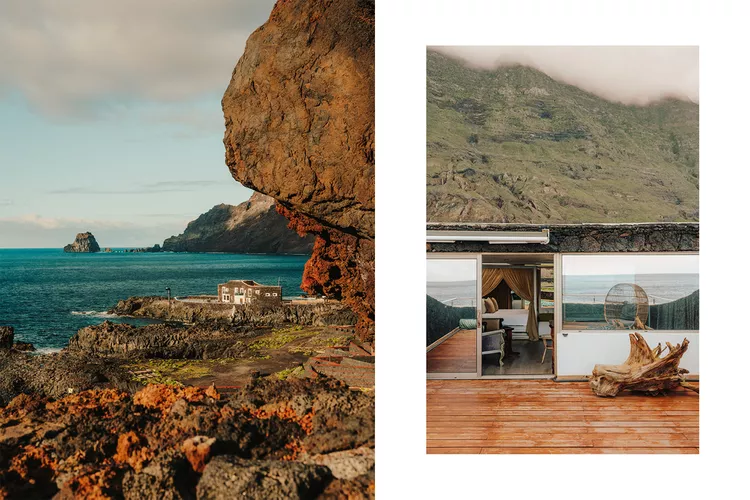
El Hierro lacks the crowded, developed beaches of its neighbors; instead, locals frequently swim in charcos, or undeveloped beachside pools that resemble creations of Poseidon. They are dispersed amid the coves, caves, and arches of the shoreline and are the product of previous volcanic activity. The Giant's Causeway in Northern Ireland is smaller than Charco Azul, which has towers of hardened lava. Evaporated puddles in the rocks had left behind crystalline sheets of sea salt, which I scraped into a plastic bag as a memento for my kitchen at home. I dove into the aquamarine water at Charco Manso and floated on my back, gazing up at the gleaming obsidian-black walls that encircled me. The rocks appeared to be moving when I blink. I decided to investigate more by swimming up close and discovered that the entire area was coated in a covering of black crabs that were scuttling sideways across the rock face.
The easiest way to see this island is by driving around aimlessly, although I did have one specific activity in mind: a visit to the interpretative center at El Hierro's southwest Parque Cultural de El Julan. There was only me inside the glass-walled structure; the rest of the island's vegetation had turned burned sienna outside, leaving the landscape scrubby and sun-baked.
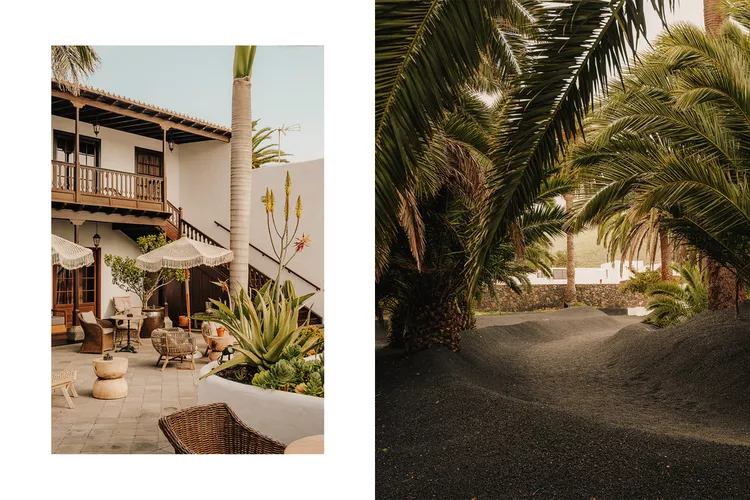
The Bimbache people first settled El Hierro at least in AD. 120, and even though there is still much that is unknown about the Bimbache, I was shocked to learn from a sign at the ethnographic display that the Guanches, the ancestors of the Bimbache, were a Berber people who originated in North Africa (perhaps Tunisia, the nation of my father), and who crossed the sea by canoe. They were very skilled at foraging in the sea and on the island.
Although El Hierro boasts a lot of natural fruit, cheeses, and fish, it hasn't been known for its culinary scene. But it started to change in 2021 when the eatery 8Aborigen opened. Chef Marcos Tavo has developed a fine-dining experience that reimagines Canarian ingredients and flavors. He was inspired by his own Indigenous ancestry and what archaeologists have learned about the Bimbache culinary culture. Everything at 8Aborigen is local, in contrast to other eateries on El Hierro that import some of their seafood from as far away as Norway.
There, attentive servers brought out earthenware dishes for my lunch that showcased creative reinterpretations of a long-forgotten cuisine, including unleavened Berber-style bread served warm with fermented goat butter and cheese, gofio crumble made from local barley, and lapas (limpets) served with a mojo made of sea fennel. These dishes were all replicas of archaeological finds from all over the archipelago. A "Berber cheesecake" with a gofio crust and olive oil foam was served for dessert.
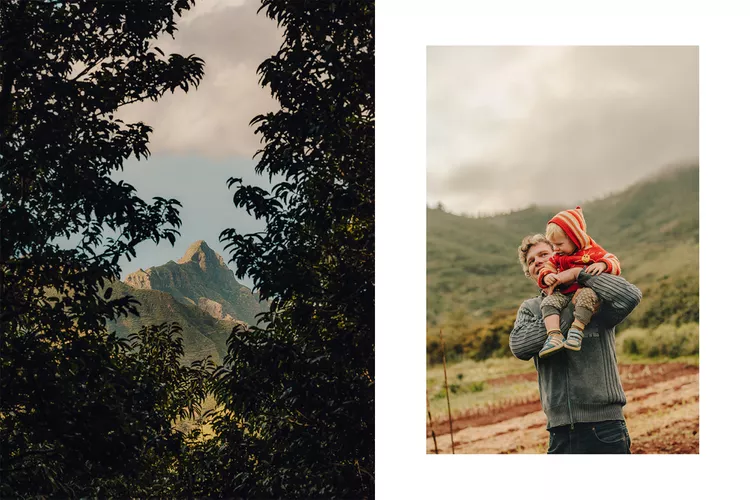
Lanzarote was the Canary Island I was most looking forward to visiting. Friends in Athens and Paris had informed me about the island's natural wines, which are known for their delicate, well-balanced bodies and high mineral content in the soil that produces grapes with an earthy, salty flavor. However, the peculiar climate has also compelled winemakers to plant creatively. Volcanic granite semicircles that serve as windbreaks are strewn across the gloomy landscape; a vibrant green vine sprouts from each ring.
I flew from the tiny airport in El Hierro on a turboprop to transfer through Tenerife, then boarded a plane that was only somewhat larger to get to Lanzarote. The experience had me silently praying and on the edge of my seat. It bears the name Lanceletto Malocello after the Genoese sailor who is credited with the "rediscovery" of the archipelago in 1312. However, its original name in the Guanche language, Tytheroygaka, which is thought to mean "one that is all ocher," is more appropriate.
Reynisfjara Black Sand Beach.. The stunning natural beauty is why the esteemed National Geographic named Reynisfjara one of the top ten most beautiful non-tropical beaches on the planet. Iceland 🇮🇸
— Wonderful Destinations by heart ❤️ (@WonderfulDest) January 20, 2023
📸 IG withluke pic.twitter.com/jbclIIsM2w
Lanzarote is characterized by its volcanic features, from César Manrique's renowned Volcano House — built amid air pockets in the volcanic rock — to the black-soil vineyards that create the island's peculiar minerally wines. The island is occasionally buffeted by the alisios, a scorching seasonal wind. Compared to El Hierro, which seemed muggy and tropical, Lanzarote appeared to be hotter and dryer. I immediately traveled to Costa Teguise, a tourist destination on the east coast, and checked into Alava Suites, a peaceful cluster of guesthouses situated around a modest plunge pool in a quiet neighborhood. The hotel's proprietor Maria Alava grew raised in Lanzarote and opened it there in 2019. She said to me, "Lanzarote means simplicity to me." The hotel's minimalist, serene design, with floor to ceiling windows overlooking gardens made of black rocks and dotted with plants that Alava had brought from nearby Fuerteventura, reflected the sentiment.
Like many other buildings in Lanzarote, Alava Suites was inspired by Manrique. In the 1980s, during the islands' construction boom, the native-born architect, painter, and sculptor successfully lobbied the local government to protect traditional buildings and architectural techniques and forbid roadside billboards because he was obsessed with the idea of preserving the island's natural beauty and protecting it from overdevelopment and overtourism.
Both the mind-bending, hedonistic 1968 Volcano House, where the artist originally resided and worked, as well as the more traditional house and studio he later employed, have been made into museums by the César Manrique Foundation. My favorite Lanzarote structure, though, is called LagOmar after Egyptian actor and idol Omar Sharif and was created by Jess Soto, a local Manrique partner. The mansion was allegedly purchased by Sharif, who later lost it in a card game; fortunately for the rest of us, its new owners have made it accessible to the public. It's a labyrinth that was built within a former quarry and wouldn't appear out of place in a James Bond film.
A fascinating counterpoint to Manrique's bizarre architectural empire are some of the island's settlements, which date back to the time of Spanish colonial authority. The following day, I left after lunch and arrived at Teguise, which once served as the Canary Islands' capital, just in time for siesta. The air was dry and thick with July heat as I walked through the deserted cobblestone streets. The town's big church stood watch over a plaza that, according to what I've heard, came alive on market days. The buildings were squat and whitewashed, with bright wooden doors. I took a stroll and then booked into the Hotel Palacio Ico, which was originally constructed in 1690 as a family home. Manrique includes Palacio Ico in his reference book Lanzarote: Unpublished Architecture because it is a prime example of the Lanzarotian style with its white walls, wooden vaulted ceilings, and shaded patio. The home was converted into a nine-room hotel in 2018 by husband and wife pair Sonsoles López and Eduardo Riestra, who kept some of the original features and added some unique touches, such a collection of vinyl LPs.
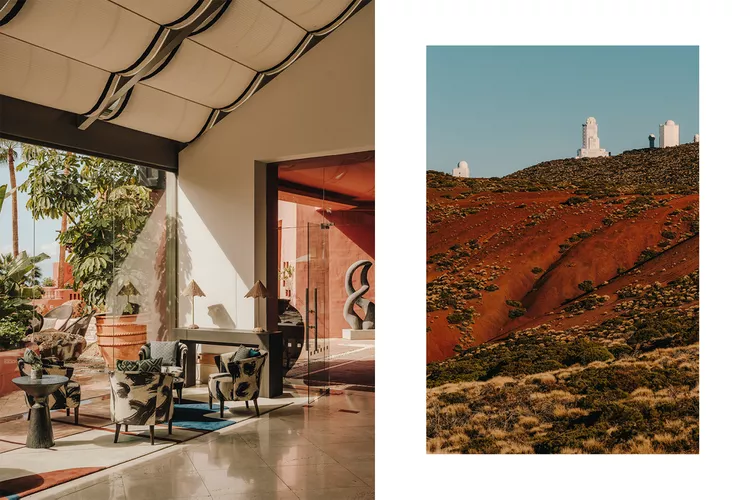
I quickly took a nap in my spacious room, and when I awoke, I saw the sun setting and knew I was running late for supper. I went to SeBe, a restaurant that Santi Benéitez and Begoa Ratón, who had relocated to the island from the mainland, had built a few years earlier. SeBe is currently the most in-demand reservation on the island, and for good reason—the duo has combined Catalan culinary expertise with Canarian products and ideas. The first plate came out with a chilly leche de tigre with kaleidoscopic dollops of prawn roe and green droplets of spicy cilantro mojo oil while a server brought me a drink of the crisp local Puro Rofe wine. The volcanic rock had refracted the sunlight into a kaleidoscope of colors, including cobalt blue, deep purple, scarlet, gold, and silver. I had first seen this while touring the southern tip of the island earlier in the day.
R elated link : This picturesque beach town is sometimes referred to as the "Hamptons of Portugal," and it is the location of a sizable population of flamingos.
However, rice dishes are SeBe's specialty, which are crispily prepared in a wood-burning oven using the rectangular pan referred to as a llauna. Veronica urged that I taste a dish that had raw, fatty tuna, dark-green rice, and sea plankton. Although the dish is meant for two people, I ate almost the entire thing since it was so good.
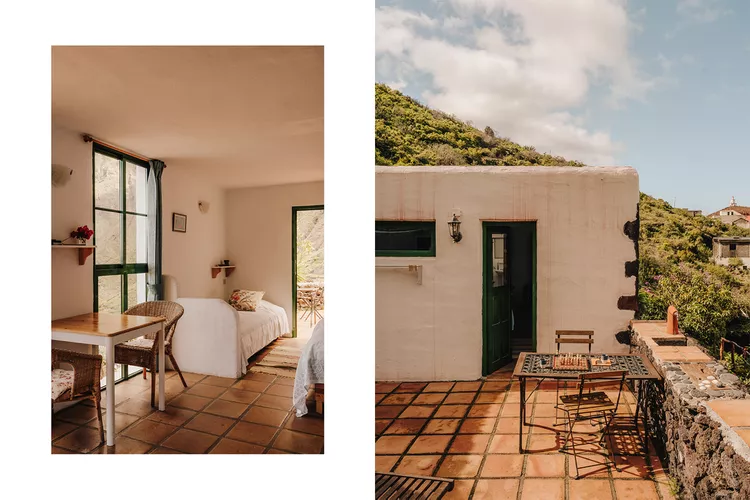
After receiving the payment and having my stomach filled with the island's riches, I went for a quick walk along the port to get some exercise. The starry sky spread out in front of me as the waves lazily lapped. Never before had the edge of the world seemed so nearby.
Exploring the Canaries' Islands
Tenerife
Places to Stay
The Ritz-Carlton, Abama: This lavish but private resort in terracotta red offers sea views and excellent service. One of the property's two Michelin-starred restaurants, Abama Kabuki, is deserving of a visit.
Places to Eat
A fashionable guanchinche (traditional Canarian cafe) serving up regional fare is La Bola de Jorge Bosch. All the highlights are included in the five-course prix fixe menu.
Steps to Take
Anaga Rural Park is a well-liked hiking location that is part of a UNESCO Biosphere Reserve and is renowned for its gorgeous laurel forest.
Organic, low-intervention Fukuoka Farm distributes produce and all-natural soaps at farmers' markets and welcomes visitors by appointment.
Teide National Park: This reserve is notable for its austere vistas and rare vegetation, including the Teide violet. It is centered around the 12,000-foot Pico de Teide.
One Hero
Places to Stay
El Sitio: Seven beautiful bungalows surrounded by lush vegetation, managed by German immigrant Sabine Willmann.
One of the most romantic accommodations in the Canaries is the Hotel Puntagrande, which boasts a magnificent setting on a point pounded by waves.
Places to Eat
Confusion: This restaurant is close to Puntagrande and is recognized more for the atmosphere than the food because it features live music on the weekends.
This El Hierro restaurant is the greatest because it offers fine-dining versions of indigenous cuisine while still managing to maintain an informal atmosphere. Both the wine list and the service are first-rate.
Steps to Take
Charcos: These grotto-like coastal pools are ideal for a picturesque swim; Charco Azul is one of the most well-known due to its vivid blue water.
The Parque Cultural de El Julan is an archaeological site containing Bimbache petroglyphs and a helpful visitors' center that requires reservations.
Lanzarote
Places to Stay
Alava Suites: Six contemporary guest suites with floor to ceiling windows with views of beautiful gardens are available. You may get breakfast delivered to your door, and the menu varies every day.
A restored 17th-century house constructed around a lovely, sun-filled courtyard is the Hotel Palacio Ico. Its restaurant features fruit, seafood, and cheese from Lanzarote.
Places to Eat
With Iberian flair, Santi Benéitez and Begoa Ratón prepare Canarian ingredients. It's hard to top the rice dishes.
Steps to Take
The late artist and architect César Manrique, who was born in Lanzarote, created a number of structures and gardens around Spain and the Canary Islands. The public is welcome to visit his former residence in the village of Hara.
LagOmar: Designed by Jess Soto, a colleague with Manrique, this maze of whitewashed structures and secret pools was reportedly briefly owned by Omar Sharif. It is still available for tour even though it is now listed for $8 million.

